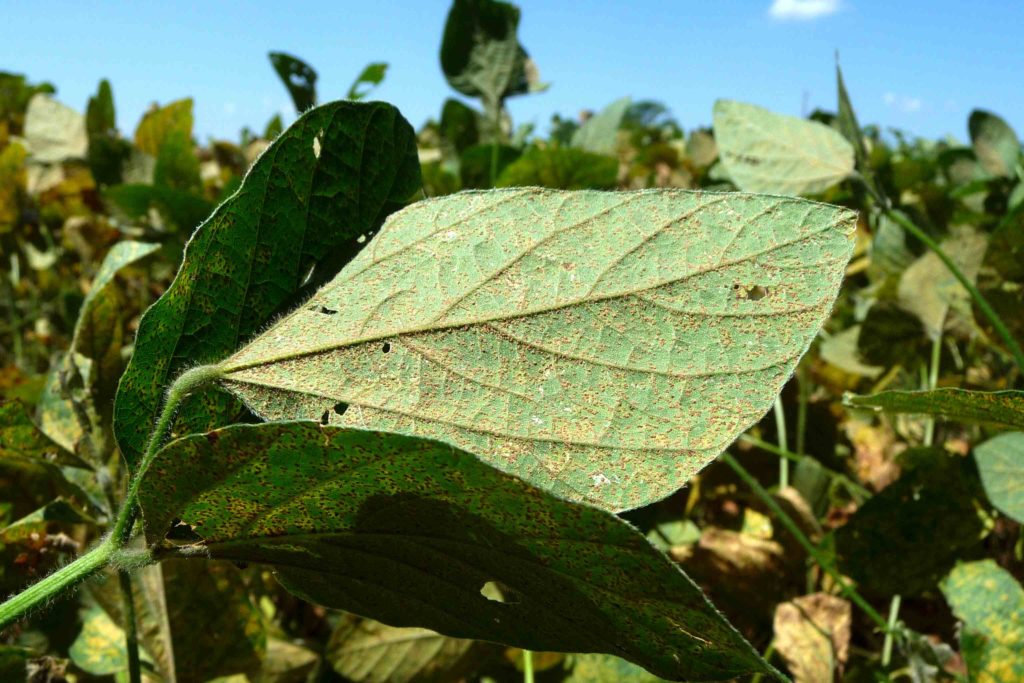6 April 2023
Genome structure of Asian soybean rust offers clues for genetic basis of its flexibility

KeyGene scientists are co-author of a paper in Nature Communications that explains the genome structure of Phakopsora pachyrhizi. This fungus causes Asian soybean rust and is known to be one of the most damaging plant pathogens of the past century. The genome proves to contain an amazing amount of jumping genes (transposons) and many genes related to amino-acid metabolism and energy production. This may cause the pathogen to be so flexible and effective in plant infection.
In 2019 the research consortium behind the paper, led by 2Blades, announced the initial successful assembly of the genome of P. pachyrhizi. Due to the genome’s very large size and complexity, further effort was required to complete the annotation and analysis. A significant challenge with P. pachyrhizi is the presence of an additional nucleus. This means that the fungus possesses two separate sets of genetic instructions. Therefore, each of the two had to be separately determined, which was recently made possible by newer, long-read sequencing technology.
“Completing the genome and analysis was a major undertaking, but we brought together the resources of a unique consortium of public and private partners and produced this high-quality annotated sequence”, stated Dr. Peter van Esse, former 2Blades Group Leader and current Board member. “The unprecedented resolution provided insights into the high degree of transposable elements within the genome, a key insight for developing resistant varieties.”
The researchers compared sequences of three geographically distinct P. pachyrhizi genomes and found a number of insights into the pathogen’s adaptability and broad host range. One of the most striking discoveries was that 93% of the genome consists of transposable elements (TEs), “jumping” DNA that can move around the genome. Most fungi have 10-40% TEs, and the high percentage in P. pachyrhizi enables greater genetic plasticity. It helps to explain P. pachyrhizi’s adaptability to environmental conditions and a range of hosts, making it a formidable threat.
Important disease
Asian Soybean Rust is ubiquitous in the soybean growing areas of Latin America. There, 210 million metric tons of soybean are projected to be produced in 2022/23 alone. This represents a gross production value of U.S. $ 115 billion per season. The largest soybean producer is Brazil. In Brasil, the cost of managing soybean rust exceeds $2 billion annually and depends heavily on fungicides.
“Asian Soybean Rust has been known to destroy up to 90% of a soybean harvest, costing soybean producers billions of dollars each year. Understanding the pathogen is critical to developing new control strategies to combat P. pachyrhizi in the field,” says study co-author Yogesh Gupta, Project Leader at 2Blades in The Sainsbury Laboratory in Norwich, UK.
Gupta continued, “An unexpected finding was the expansion of genes related to amino-acid metabolism and energy production, atypical for a rust fungus. These genes may correlate with infection across many legume species since it may provide flexibility for nutrient acquisition from different hosts.”
KeyGene's contribution

“The exceptional long reads from the Oxford Nanopore platform resulted in a highly contiguous genome assembly for the studied UFV02 isolate of the fungus. The resulting reference genome has a larger assembly size while the number of contigs was less than half compared to the other two isolates earlier analyzed.” says Antoine Janssen, Team Leader Bioinformatics at KeyGene..
For this research, the PromethION platform of Oxford nanopore technology (ONT, Oxford, UK) was used for long-read sequencing at KeyGene in Wageningen. The libraries with long DNA fragments were constructed and sequenced on the PromethION platform. First, raw sequencing data of 110 Gbp was generated and was base-called using ONT Albacore v2.1 available at https://community.nanoporetech.com. After that, the longest nanopore reads were assembled using a state-of-the art pipeline. To improve the consensus, error correction was performed with Racon. The resulting assembly was polished with Illumina data.
The effort behind the project comprised a large and interactive international consortium of research and industry partners. This included 2Blades, The Sainsbury Laboratory, Brazilian Company of Agricultural Research (Embrapa), Pathogen Evolutionary Ecology, National Center for Genome Resources, U.S. Department of Energy Joint Genome Institute, Federal University of Technology of Paraná (UTFPR), Université de Lorraine, Syngenta Jealott’s Hill Int. Research Centre, AFMB Aix-Marseille University, Biodiversité et Biotechnologie Fongiques (INRAE), King Abdulaziz University, Technical University of Denmark, Bayer SAS, KeyGene N.V., John Innes Centre, Universidade Federal de Viçosa, University of Hohenheim, Syngenta Crop Protection AG, RWTH Aachen University, Syngenta Crop Protection, and the University of California, Berkeley.
Read more
- Nature Communications paper ‘Major proliferation of transposable elements shaped the genome of the soybean rust pathogen Phakopsora pachyrhizi’, April 2023
- Complete genome of devastating Asian soybean rust fungus assembled, news item on keygene.com, October 2019